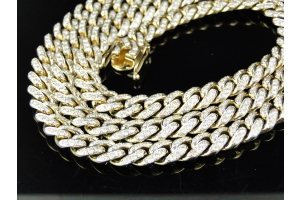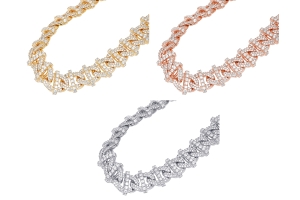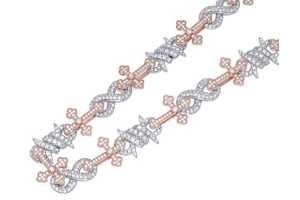

Rolex isn’t like any other watch brand. Rolex is a world of its own: respected; valued; and known over the globe for its luxury watches. Rolex simply makes watches but their timepieces have  taken on a role beyond that of mere timekeeper. Having said that, the reason a “Rolex is a Rolex” is because they are good watches and tell pretty good time.
taken on a role beyond that of mere timekeeper. Having said that, the reason a “Rolex is a Rolex” is because they are good watches and tell pretty good time.
Diamond Rolex watches, Gold Rolex watches have become a benchmark of luxury. The most supreme and elite brand of timepieces. Rolex hasn’t gained this reputation so easily. It is owing to fact that each of their watches is made with great detail and attention. Here is what makes Rolex so unique and why you should have one.
1. Rolex uses a unique and expensive steel
 Numerous watch enthusiasts know that Rolex uses a kind of steel that nobody else uses. Stainless steel isn't all the same. Steel comes in various types and grades… and most steel watches are made from a type of stainless steel called 316L. Today, all the steel in Rolex watches is made from 904L steel, and as far as we know, pretty much no one else does. Why?
Numerous watch enthusiasts know that Rolex uses a kind of steel that nobody else uses. Stainless steel isn't all the same. Steel comes in various types and grades… and most steel watches are made from a type of stainless steel called 316L. Today, all the steel in Rolex watches is made from 904L steel, and as far as we know, pretty much no one else does. Why?
Rolex used to use the same steel as everyone else, but in around 2003 they moved their entire steel production to 904L steel. In 1988 they released their first 904L steel watch with a few versions of the Sea-Dweller. 904L steel is more rust and corrosion resistant, and is somewhat harder than other steels. Most important to Rolex, is that 904L steel, when worked properly, is able to take (and hold) polishes incredibly well. If you’ve ever noticed that steel on a Rolex watch looks different than other watches, it is because of 904L steel, and how Rolex has learned to work with it.
2. Rolex has its own science lab

Given everything Rolex has done over the years it shouldn't come as an unexpected that they have a Research and Development department. In any case, Rolex takes it well past that. Rolex has not one, but rather a few different kinds of proficient science labs at their different offices. The motivation behind these labs isn't simply to investigate new watches and things that may go into watches, but also to research more effective and efficient manufacturing. One way of looking at Rolex is that they are an extremely competent and almost obsessively organized manufacturing company – that just happens to make timepieces.
Rolex labs are as diverse as they are stunning. Perhaps the most visually interesting is the chemistry lab. Full of beakers and tubes that carry liquids and gases, the Rolex chemistry lab is full of highly trained scientists. What is it mostly used for? Well one thing that Rolex stated is that the lab is used for developing and researching oils and lubricants that they use in machines during the manufacturing process.
A fascinating room is the pressure test room. Here watch movements, bracelets, and cases undergo simulated wear and abuse on custom-made machines and robots. Let’s just say that it would not be unreasonable to assume your typical Rolex is designed to last a lifetime (or two).
3. Rolex watches are all hand assembled and tested

One of greatest confusions about Rolex is that machines manufacture their watches. In all actuality Rolex watches are made completely by hand, something that can be expected from a fine, Swiss Luxury Watch.
However, Rolex does use machines in the process. Truth be told, Rolex effectively has the most refined watch making apparatus on the planet. The robots and other automated tasks are used for tasks that humans aren't as efficient at. These include sorting, filing, cataloguing, and very delicate procedures that involve the type of care you want a machine to handle. Most of these machines are still human-operated though. And everything from Rolex movements to bracelets are assembled by hand. A machine however helps with doing things such as applying the right pressure when attaching pins, aligning parts, and pressing down hands. Having said that, all Rolex watch hands are still set by hand via a trained technician.
4. An in house foundry makes the gold for Gold Rolex Watches
 Rolex makes their own gold. While they have suppliers for steel (Rolex still works the steel in-house to make every one of the parts), all the gold and platinum is made in-house. 24k gold comes into Rolex and it is transformed into 18k yellow, white, or Rolex Everose gold (their non-blurring form of 18k rose gold).
Rolex makes their own gold. While they have suppliers for steel (Rolex still works the steel in-house to make every one of the parts), all the gold and platinum is made in-house. 24k gold comes into Rolex and it is transformed into 18k yellow, white, or Rolex Everose gold (their non-blurring form of 18k rose gold).
Large kilns are used to soften and blend the metals which are then transformed into cases and bracelets. Because Rolex controls the generation and machining of their gold, they can entirely guarantee quality, as well as the most attractive parts. As far as anyone is concerned Rolex is the only watch manufacturer that makes their own particular gold or even has a genuine foundry in-house.
5. Technology at Rolex

The philosophy at Rolex seems to be very pragmatic, if a human does it better, then let a human do it, if a machine does it better, then let a machine do it. In fact the reason more watchmakers don’t use machines is two-fold. First of all machines are huge investments and in many instances keeping people around to do it is less expensive. Second, they don’t have the production demands that Rolex does. In fact, Rolex is fortunate to have the ability to equip its facilities with robotic help where needed.
6. Rolex watches are individually tested in pressure tanks
 All Rolex Oyster case watches are tested for water resistance. The way that this is often done at watch manufactures is with an air-pressure tank. A watch is placed in a small chamber that is filled with air, and if the pressure changes at all, it means that air leaked into the case. Each Rolex Oyster, as well as Oyster dive watches begins with this air pressure treatment. In fact, each case is tested both before and after a movement and dial are placed inside of it.
All Rolex Oyster case watches are tested for water resistance. The way that this is often done at watch manufactures is with an air-pressure tank. A watch is placed in a small chamber that is filled with air, and if the pressure changes at all, it means that air leaked into the case. Each Rolex Oyster, as well as Oyster dive watches begins with this air pressure treatment. In fact, each case is tested both before and after a movement and dial are placed inside of it.
After the watches exit the tank, they are heated up and a drop of cold water is placed on the crystal to see if condensation forms. An optical sensor then scans them for trace amounts of water. Less than one in a thousand watches fail the test. The story is much more intense for Deep-Sea watches. Rolex co-developed a special high-pressure water tank with COMEX to depth test each Deep-Sea watch. The pressure tank looks like something from a science fiction movie. Imagine something that looks like a several ton Gatling gun. This machine takes well over an hour and measures each watch to a pressure equivalent to 12,000 meters deep.
7. Rolex has top gemologists working for them
 It has been said that Rolex has absurd standards for the materials it purchases from its suppliers. This incorporates things like metals and in addition valuable stones, for example, precious stones, rubies, and emeralds. Rolex has an enormous gemological office whose objective it is to purchase, test, organize, and set jewels and different valuable stones in a range of Rolex models. Something they do is check incoming stones to guarantee that they are genuine. Using x-beams for instance, they can test jewels to guarantee they aren't fake.
It has been said that Rolex has absurd standards for the materials it purchases from its suppliers. This incorporates things like metals and in addition valuable stones, for example, precious stones, rubies, and emeralds. Rolex has an enormous gemological office whose objective it is to purchase, test, organize, and set jewels and different valuable stones in a range of Rolex models. Something they do is check incoming stones to guarantee that they are genuine. Using x-beams for instance, they can test jewels to guarantee they aren't fake.
Rolex reports that in the years they have been testing diamonds, just two out of 20 million have been fake. That may appear like a very small probability that it is not even worth performing the test. However, to guarantee supreme quality, Rolex tests each cluster of precious stones. This should also have an illustrative effect on the diamonds they use, which happen to only be IF in clarity, and D-G in color (the four grades closest to white).
Every single jewel or valuable stone (regardless of how huge or little) on a Rolex watch is hand-picked and hand-set. Rolex employs gem specialists to make custom settings for stones in their most elite watches, done using similar procedures used in making the world's best jewelry.
8. A Rolex takes approximately year to finish
A promotion for Rolex long ago claimed that it takes about a year to make a single Rolex watch. As unbelievable as that sounds, it is true even today. Rolex creates just about a million watches every year, but shockingly, no easy routes are taken in the assembling procedure. Rolex is however interested in quality and efficiency. Basically, the entire company seems focused on producing the best watches, and continually seeing how they can make them better.
If you look at Rolex watches over time, they are more about evolution rather than revolution. This idea of always improving versus changing goes right into their manufacturing process as well. They are constantly learning how to improve quality through better processes and techniques. The move from aluminum to ceramic bezel inserts is a perfect example. Nevertheless, from starting to shape the parts of the case to testing a completed watch for accuracy, the process takes around one year.
Of course Rolex could speed this up for certain models if necessary, but each watch requires so many parts and virtually everything is made from base materials in-house. Once all the parts for a Rolex watch are completed, they are then mostly hand-assembled and individually tested. The testing and quality assurance process is rather intense.
A good example is how Rolex makes each of their watch dials. All of the dials are made in-house, and one of the most impressive facts is that all of the applied hour markers are set individually by hand. Often times at other brands, machines perform this process, but Rolex learned that a human eye is better trained to spot problems. So individual hour markers are applied and riveted by hand. Dials are dropped from 20cm up in the air to ensure that none of the hour markers fall out. This is a careful and time-consuming process, and it is among the many elements of making watches at Rolex that is done by a skilled human being. Taken together, because of Rolex’s rather fanatical dedication to quality across their huge production, watches take, on average, about a year to produce.
9. Rolex makes almost everything in-house
After having said all of the above, it probably doesn’t come as a big surprise that Rolex makes virtually everything in-house as a totally vertically integrated manufacturer. As of right now, the only major parts that Rolex doesn’t make for all of their watches are the synthetic sapphire crystals and many of the dial hands, however it seems this too shall change over the years. Rolex produces their own gold, cases, bracelets, dials, bezels, and movements in-house with incredible efficiency and quality.
It isn’t just that Rolex can afford all the most useful machines, but also that Rolex invests into processes and techniques that are tightly-held trade secrets. The real value inside the Rolex factory are their tools and know-how, which no one could replicate even if they had a copy of their facilities.
Making everything in-house allows Rolex to be truly independent. Watch collectors often agree that there is the watch industry and then there is Rolex – the two just happen to make similar products. It is hard to love watches and not appreciate what Rolex is and what they produce. It is not difficult to understand why they aren’t only the most successful high-end watch manufacture, but why they are also one of the most successful luxury brands in the world.
In conclusion, there is only one last thing about Rolex, it is that even if you personally don’t like how their products look on your wrist (which puts you in a minority or people if, after a few years, you don’t appreciate at least some models), you simply can’t deny the absolute sense of confidence, reliability, and dignity the brand name communicates.









